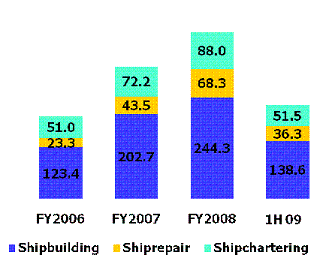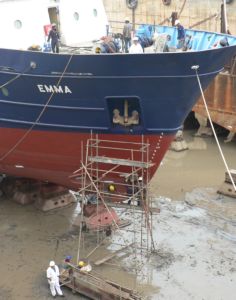
www.sharesinvestment.com
ASL MARINE Holdings started out in 1974 trading scrapped steel materials and successfully morphed into a vertically integrated marine company in the 1980s with it core business in shipbuilding, shiprepair and shipchartering.
The company started out with a fleet of 96 vessels (mostly tugs and barges) when it made its Mainboard debut on 17 March 2003.
Since then, the number of vessels have grown steadily to 178 as at 31 December 2008.

ASL revenues in S$ million.
Posting Healthy Growth
On 11 February 2009, ASL released its 1H09 results showing that revenue was 17% higher than that of 1H08.
Earnings grew a commendable 43.7% y-o-y, buoyed mainly by higher revenue and a $14.5m gain from the disposal of plant and equipment and vessels held for sale.
All 3 core business segments registered growth despite the ever worsening global economic environment.
Increased progressive recognition of more and higher value shipbuilding projects, increased higher value shiprepair jobs and higher proportion of time charter and a larger fleet size for shipchartering accounted for the higher 1H09 revenue.
Order book as at 31 December 2008 stood at $663m for the shipbuilding operations.
These contracts involve building of 42 vessels and are scheduled for delivery till mid 2011. 26% of the $663m is expected to be realized in 2H09.
Gross profit margin dipped slightly to 18.4% against 18.7% in 1H08. Net margin increased to 17.8% from 14.5% in 1H08.
There was a resultant outflow of $8.5m in cash and cash equivalents for 1H09 bringing cash and cash equivalents at end of 1H09 to $94.5m.

Shipbuilding contributes about two-thirds of ASL revenues. Photo of vessel under repair at ASL by Leong Chan Teik.
Cash from operating activities was $17.3m (1H08: $78.4m) whereas capital expenditure was $26.6m (1H08: $50m).
In view of the credit crunch, ASL’s cash on hand of $94.5m should be more than able to cover its short term borrowings and debt securities of $52.9m.
Gearing ratio (interest bearing loans and borrowings / shareholders’ equity) was 0.52, down from 0.58 in 1H08.
As at the time of writing, ASL was trading at historical PE ratio of 2.2x and PB ratio of 0.52x. ROE from FY04 to FY08 has averaged 22%.
Comparatively, ASL’s results have outshone its peers including Marco Polo Marine and Jaya Holdings, both of which showed lower year-to-date earnings.
Challenges Ahead
One of ASL’s strategies is to focus on the less cyclical shiprepair and shipchartering business where the gross margins are higher as compared to shipbuilding.
The shipbuilding business is expected to remain soft in the near future.
Although 61% of its revenue was generated from shipbuilding, upon closer examination, one finds that the bulk contributor of gross profit came from the other 2 segments.
Despite the apparent weakness in the industry, ASL remains hopeful of the long term prospects in the shiprepair segment as there is an increased global fleet and whereby maintenance and repair works are mandatory.
For the shipchartering business, ASL intends to increase its shipchartering fleet by another 19 vessels (worth $77m).
Nine out of the 19 will be built internally.
| Report Date | Broker | Call | Target Price |
| 12 Feb 2009 | DMG-OSK | Buy | 55 cents |
| 12 Feb 2009 | UOB Kayhian | Hold | 57 cents |
| 12 Feb 2009 | Kim Eng | Buy | S$1.62 |
| 12 Feb 2009 | DBS Vickers | Buy | 82 cents |
Consequent to the release of its 1H09 results, DMG & Partners issued a Buy call on ASL with a target price of $0.55.
DMG said, “We continued to like ASL for its prudent and quality management, strong balance sheet and clear business guidance”.
Similarly, DBS Vickers also issued a Buy call albeit with a higher target price of $0.84.
Originally published at www.sharesinvestment.com, this article is reproduced here as part of a collaboration with NextInsight.





